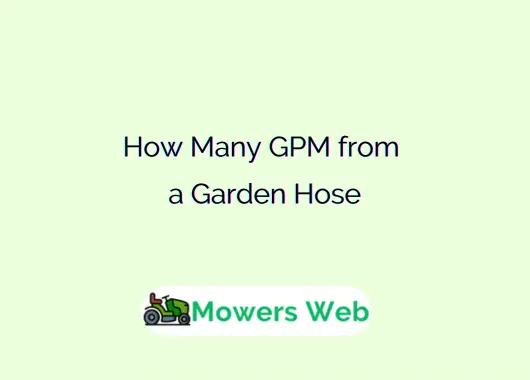In this post guide, we’ll dive into the details of garden hose flow rates, explore what influences them, and provide practical tips to optimize water flow for your needs.
How Many GPM from a Garden Hose
A standard garden hose typically delivers 2 to 6 gallons per minute (GPM), depending on factors like hose diameter (½-inch, ⅝-inch, or ¾-inch), length, water pressure (usually 40–60 PSI), and attachments like nozzles. A ⅝-inch hose, the most common for household use, averages 4–6 GPM under typical conditions.
Longer hoses or restrictive nozzles can reduce flow, while larger diameters and higher pressure increase it. To estimate your hose’s GPM, measure how long it takes to fill a 5-gallon bucket and calculate: (gallons ÷ seconds) × 60.
Related How to Repair Expandable Garden Hose(In 5 Quick Steps)
Factors Affecting Garden Hose Flow Rate
1. Hose Diameter
The diameter of a garden hose is one of the primary factors affecting its flow rate. Common garden hose diameters are ½ inch, ⅝ inch, and ¾ inch, with ⅝ inch being the most popular for household use.
- ½-inch hoses: These are smaller and typically deliver 2 to 4 GPM. They’re suitable for light tasks like watering small gardens, but may feel underpowered for larger jobs.
- ⅝-inch hoses: The standard choice for most homeowners, these deliver 4 to 6 GPM, offering a good balance of flow and manageability.
- ¾-inch hoses: Used for heavy-duty tasks, these can deliver 6 to 10 GPM or more, ideal for large gardens or commercial applications.
A larger diameter allows more water to flow through, increasing the GPM, but it also makes the hose heavier and less flexible.
Related How to Use Greenworks Pressure Washer With Soap
2. Hose Length
The length of the hose impacts water pressure and, consequently, the flow rate. Longer hoses experience more friction loss as water travels through them, reducing the GPM. For example:
- A 50-foot ⅝-inch hose might deliver 5 GPM at 40 PSI (pounds per square inch).
- A 100-foot hose of the same diameter might drop to 4 GPM due to friction loss.
To maximize flow, use the shortest hose length possible for your task.
3. Water Pressure
Household water pressure typically ranges from 40 to 60 PSI, though it can vary depending on your location and plumbing system. Higher pressure increases the GPM, while lower pressure reduces it. For instance:
- At 40 PSI, a ⅝-inch hose might deliver 4 GPM.
- At 60 PSI, the same hose could deliver closer to 6 GPM.
You can measure your home’s water pressure using a pressure gauge attached to an outdoor faucet. If pressure is too low, a booster pump might help, but be cautious not to exceed the hose’s pressure rating.
Related What Type of Oil for a Pressure Washer(+Top 3 Best Oil Picks)
4. Nozzles and Attachments
Nozzles, sprinklers, or other attachments can significantly alter the flow rate. A wide-open nozzle might allow the full GPM potential, while a spray nozzle with a fine mist setting can reduce the flow to less than 1 GPM. Adjustable nozzles give you control but may restrict flow compared to an open-ended hose.
5. Hose Material and Quality
The material and construction of the hose also matter. Cheap hoses with thin walls or kinks can restrict water flow, lowering the GPM. High-quality hoses with smooth inner linings reduce friction and maintain better flow rates.
Estimating GPM for Your Hose
To estimate the GPM of your garden hose, you can perform a simple test:
- Attach the hose to an outdoor faucet and ensure no nozzles or restrictions are in place.
- Turn the water on fully and let it flow into a bucket with known volume markings (e.g., a 5-gallon bucket).
- Time how long it takes to fill the bucket (e.g., 30 seconds to fill 5 gallons).
- Calculate GPM: Divide the bucket’s volume by the time in seconds and multiply by 60. For example, 5 gallons ÷ 30 seconds × 60 = 10 GPM.
This method provides a rough estimate, as factors like pressure fluctuations or hose condition can affect results.
Related Mower Productivity Calculator
Typical GPM Ranges
Here’s a quick reference for typical GPM ranges under standard conditions (40–60 PSI, no attachments):
- ½-inch hose: 2–4 GPM
- ⅝-inch hose: 4–6 GPM
- ¾-inch hose: 6–10 GPM
For precise applications, consult the hose manufacturer’s specifications, as some hoses are designed for higher or lower flow rates.
Tips to Optimize Your Hose’s Flow Rate
- Choose the Right Hose: Select a diameter and length suited to your needs. A ⅝-inch, 50-foot hose is versatile for most home tasks.
- Check for Kinks: Ensure the hose is free of kinks or twists, which can drastically reduce flow.
- Maintain Your Hose: Store it properly to prevent damage and clean it periodically to remove debris.
- Use High-Quality Fittings: Poorly designed connectors or nozzles can restrict flow.
- Monitor Water Pressure: If your pressure is consistently low, contact your water provider or consider a booster pump.
- Match Attachments to Tasks: Use high-flow nozzles for filling containers and low-flow settings for delicate plants.
Related Lawn mower Oil Capacity Calculator
Practical Applications of GPM Knowledge
Understanding your hose’s GPM helps you plan tasks efficiently:
- Gardening: Delicate plants may need a low GPM (1–2) to avoid soil erosion, while lawns benefit from 4–6 GPM.
- Filling Pools or Tanks: A higher GPM (6–10) speeds up the process.
- Pressure Washing: Some pressure washers require a minimum GPM (e.g., 2–3) to function effectively, so check your hose’s output.
Final words
The GPM from a garden hose typically ranges from 2 to 10 GPM, depending on the hose’s diameter, length, water pressure, and attachments. By understanding these factors and testing your hose’s flow rate, you can choose the right equipment and optimize water usage for any task. Whether you’re nurturing a garden or tackling a heavy-duty cleaning job, knowing your hose’s GPM empowers you to work smarter, not harder.




